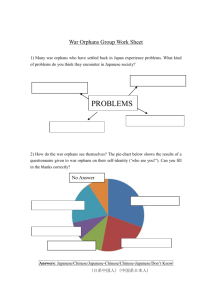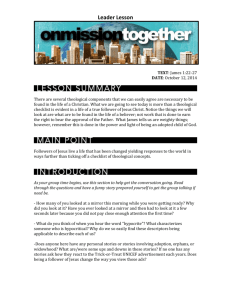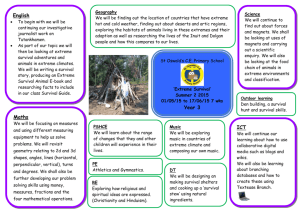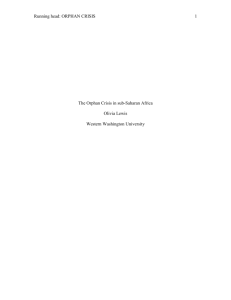Sex differences in the consequences of maternal loss in a long
advertisement
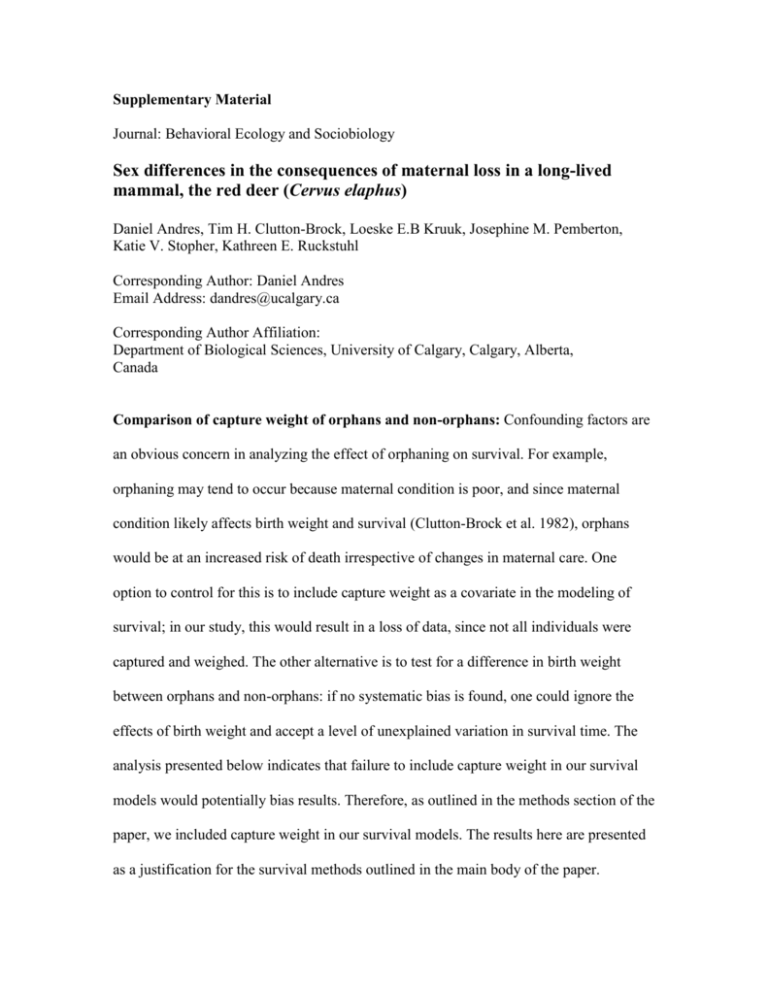
Supplementary Material Journal: Behavioral Ecology and Sociobiology Sex differences in the consequences of maternal loss in a long-lived mammal, the red deer (Cervus elaphus) Daniel Andres, Tim H. Clutton-Brock, Loeske E.B Kruuk, Josephine M. Pemberton, Katie V. Stopher, Kathreen E. Ruckstuhl Corresponding Author: Daniel Andres Email Address: dandres@ucalgary.ca Corresponding Author Affiliation: Department of Biological Sciences, University of Calgary, Calgary, Alberta, Canada Comparison of capture weight of orphans and non-orphans: Confounding factors are an obvious concern in analyzing the effect of orphaning on survival. For example, orphaning may tend to occur because maternal condition is poor, and since maternal condition likely affects birth weight and survival (Clutton-Brock et al. 1982), orphans would be at an increased risk of death irrespective of changes in maternal care. One option to control for this is to include capture weight as a covariate in the modeling of survival; in our study, this would result in a loss of data, since not all individuals were captured and weighed. The other alternative is to test for a difference in birth weight between orphans and non-orphans: if no systematic bias is found, one could ignore the effects of birth weight and accept a level of unexplained variation in survival time. The analysis presented below indicates that failure to include capture weight in our survival models would potentially bias results. Therefore, as outlined in the methods section of the paper, we included capture weight in our survival models. The results here are presented as a justification for the survival methods outlined in the main body of the paper. In this analysis, we used a matched design to compare weights of orphans and non-orphans. Observations were matched by year of birth, sex, age weighed and ‘event age’ (see below). The matched set each observation belonged to was fitted as a random effect. All animals were weighed within 13 days of birth. Non-orphan deer were matched to individual orphans if their age at weighing was within plus or minus 12 hours of the orphan’s age at weighing. Mortality risk declines with age and birth-weight (CluttonBrock et al. 1982), and as a consequence animals that survive long enough to lose their mothers will tend to survive longer and be heavier than the starting crop of deer. Therefore, we randomly matched non-orphans to orphans if non-orphan survival time (months) was equal or greater than the age (months) orphans lost their mother; we refer to this as ‘event age’ matching. Orphans with mothers dying from shooting were excluded from this analysis. Birth-weight was analyzed using general linear mixed models with orphan status (orphaned or not) as a fixed effect and event age match ID as the random effect. In this analysis, an orphan is defined as any individual losing its mother prior to an age of 36 months. Males and females were analyzed separately in these comparisons. The denominator degrees of freedom was adjusted according to the Kenward Roger technique assuming the correlation among responses follows compound symmetry; AIC was used to select among compound symmetry, heterogeneous compound symmetry and unstructured covariances). Under compound symmetry, the covariance between treatments is assumed to be the same, as is the variance within treatments. With the above models the data displayed slight deviations from normality and this was confirmed by Kolmogorov-Smirnov tests (P<0.15); deviations were associated with heavy tails and/or outliers, and this could not be remedied with transformations. The departures from normality have the effect of reducing statistical power. In spite of this, we found that orphan males were significantly heavier at birth compared to their nonorphan counterparts (0.37 kg heavier +/- 0.14 SE, F1 df, 333 ddf =2.62, P=0.009). Female orphans were also significantly heavier than non-orphans (0.48 kg heavier +/-0.15 SE, F1 df, 317 ddf = 3.18, P=0.002). Therefore, failure to include capture weight as a covariate in our survival models would lead to an under-estimate of the orphaning effect. References Clutton-Brock TH, Guinness FE, Albon SB (1982) Red deer: behavior and ecology of two sexes. The University of Chicago Press, Chicago
